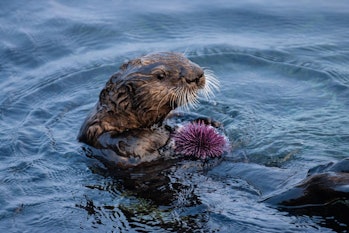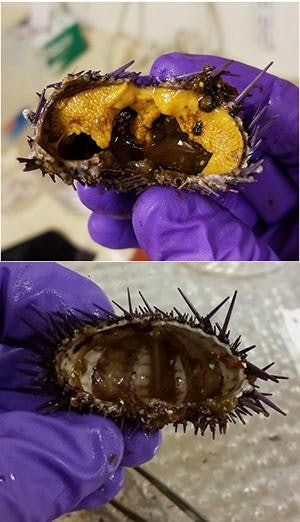The 'zombie urchin' is a harbinger of doom
When a team of scuba-diving marine biologists explored reefs off the central coast of California, they found themselves repeatedly swimming through lush kelp forests interspersed with patches of barren ocean. The seemingly empty spaces looked like they were covered under a purple carpet.
The scientists continued to observe this mosaic of barren deserts and kelp forests after repeated underwater trips over the course of a three-year-long survey. What drives this underwater deforestation are small spiky marine animals called purple sea urchins.
These creatures feast on kelp.
Joshua Smith is the study’s lead author and a Ph.D. candidate in the department of ecology and evolutionary biology at the University of California, Santa Cruz. What his team found up and down the coast was “widespread kelp deforestation,” Smith tells Inverse.
“These purple sea urchins had converted many underwater kelp forests into deserts — or what we call ‘sea urchin barrens,’” Smith says.
On Monday, Smith and his colleagues revealed what allows this cycle of feasting-and-destruction to continue: the preferences of sea otters. These animals avoid the so-called “zombie urchins” living in barren spaces, preferring the more nutrient-rich urchins living in kelp forests. Meanwhile, the less desirable urchins continue to prevent kelp forests from growing.
This finding was published in the journal Proceedings of the National Academy of Sciences.
Necessary background — Sunflower sea stars are voracious predators capable of swallowing entire sea urchins. In 2013, these sea stars were wiped out from the Northeast Pacific Ocean after succumbing to a mysterious outbreak of sea star wasting syndrome.

A sea otter in Monterey Bay California dines on a purple urchin. Morgan Rector
At the time, scientists were optimistic. Another major predator of pesky purple urchins are sea otters. As apex predators, sea otters are essential for the survival of different marine ecosystems like kelp forests and eelgrass in estuaries.
Without these fluffy engineers, millions of sea urchins could devour entire kelp forests or too many crabs in California’s estuaries could result in microalgae smothering seagrass.
Kelp forests comprise large brown algae and can grow up to 18 inches each day. They are home to entire ecosystems of fish, invertebrates, and marine mammal species like sea otters. Kelp forests are also vital for climate change mitigation because of their ability to capture carbon dioxide through photosynthesis.
But a year later, in 2014, a colossal marine heatwave resulted in the decline of kelp forests that only grow and thrive in cold, nutrient-rich water. This study describes how these ghastly turns of events caused a fundamental shift in the behavior of purple sea urchins, finding they have continued to survive in a starved state for years after eating any remaining kelp or algae in their “barrens”.

An urchin barren in Monterey Bay, California. Starved urchins remove kelp and algae. Michael Langhans
In healthy kelp forests, purple sea urchins normally live in the crevices of the reef where they eat drift kelp — similar to dining on leaves falling from a tree.
In their natural habitats, not only are they hiding from their predators, but their food is home delivered to them. They usually have no reason to leave those crevices. However, after the 2014 marine heatwave, the urchins lost access to drift kelp. So, they were forced to come out to the surface of the reef in search of food.
What’s new — The new study suggests sea otters are now ignoring starved out urchins in barrens and are instead choosing the healthy ones that live in the remaining patches of kelp forests.
“After dissecting urchins from these barrens in the lab, we found they are empty on the inside,” Smith explains.
“They could still reproduce but they choose to store energy for survival.”
Purple sea urchins’ gonads, or reproductive organs, are an expensive delicacy called “uni” in Japan. Uni is mostly consumed as sushi. The gonads are also the primary energy storage organ in sea urchins.
“It is almost impossible for any kelp to regrow because the starving urchins gobble them up immediately.”
Commercial divers get the most value for an urchin that has healthy gonads and lives in a kelp forest.
“They know it is best to avoid urchins in barrens as their gonads are almost empty due to starvation,” Smith explains.
“Sea otters are doing the same thing. Despite having easy access to their prey in purple sea urchin barrens, we observed they are foraging almost entirely on healthy urchins who live in kelp forests.”
While living in clusters on the surface of reefs in their barren underwater deserts, the spiky animals can slow down their metabolism as they go into a “sit and wait” mode while eagerly waiting for any kelp to show up.
“It is almost impossible for any kelp to regrow because the starving urchins gobble them up immediately,” Smith says.
The big takeaway — Sea otters still help kelp forests thrive by hunting sea urchins from their natural habitats in the crevices of reefs and preventing overgrazing. However, since otters choose not to forage in purple sea urchin barrens, they are not contributing to the recovery of kelp forests, Smith explains.
“Our study reveals how the behavior of predators in response to the behavior and condition of their prey influences the persistence of ecosystems,” he says.

The top urchin is healthy, the bottom urchin is starved — but alive.Michael Langhans
During an urchin outbreak in California in 2019 — a time when their population soared 10,000 percent in five years — Smith and his team also observed that the otters started eating more urchins in kelp forests than before.
“Our findings detail that these are important behavioral elements that could help in motivating our understanding of how these interactions might work in other marine, as well as terrestrial, ecosystems around the world,” he says.
However, it’s possible sea otters won’t have to carry the burden of curbing populations of sea urchins alone.
“An urchin disease could potentially have the biggest effect in the future,” Smith says. “Another possibility is a large winter storm could potentially scour the bottom of the ocean and wipe zombie urchins off the reef.”
It’s also possible that other sources of predation will emerge. For instance, Smith explains, populations of sunflower sea stars might recover — and the cycle of consumption will continue.
Abstract: Consumer and predator foraging behavior can impart profound trait-mediated constraints on community regulation that scale up to influence the structure and stability of ecosystems. Here, we demonstrate how the behavioral response of an apex predator to changes in prey behavior and condition can dramatically alter the role and relative contribution of top-down forcing, depending on the spatial organization of ecosystem states. In 2014, a rapid and dramatic decline in the abundance of a mesopredator (Pycnopodia helianthoides) and primary producer (Macrocystis pyrifera) coincided with a fundamental change in purple sea urchin (Strongylocentrotus purpuratus) foraging behavior and condition, resulting in a spatial mosaic of kelp forests interspersed with patches of sea urchin barrens. We show that this mosaic of adjacent alternative ecosystem states led to an increase in the number of sea otters (Enhydra lutris nereis) specializing on urchin prey, a population-level increase in urchin consumption, and an increase in sea otter survivorship. We further show that the spatial distribution of sea otter foraging efforts for urchin prey was not directly linked to high prey density but rather was predicted by the distribution of energetically profitable prey. Therefore, we infer that spatially explicit sea otter foraging enhances the resistance of remnant forests to overgrazing but does not directly contribute to the resilience (recovery) of forests. These results highlight the role of consumer and predator trait-mediated responses to resource mosaics that are common throughout natural ecosystems and enhance understanding of reciprocal feedbacks between top-down and bottom-up forcing on the regional stability of ecosystems.
By accepting you will be accessing a service provided by a third-party external to https://oc3anclub.com/

